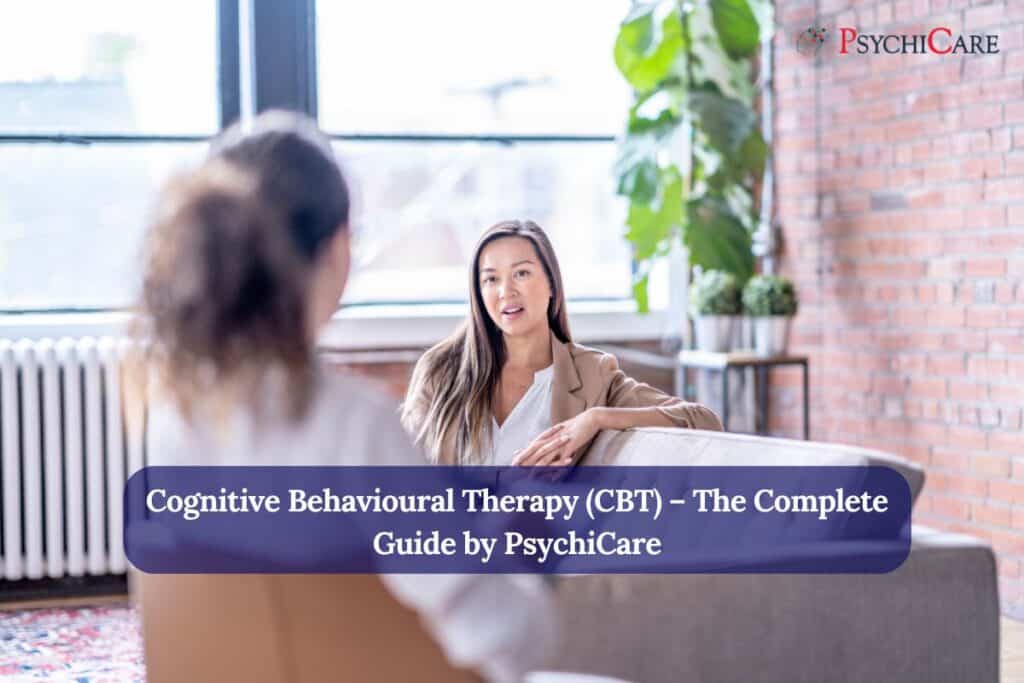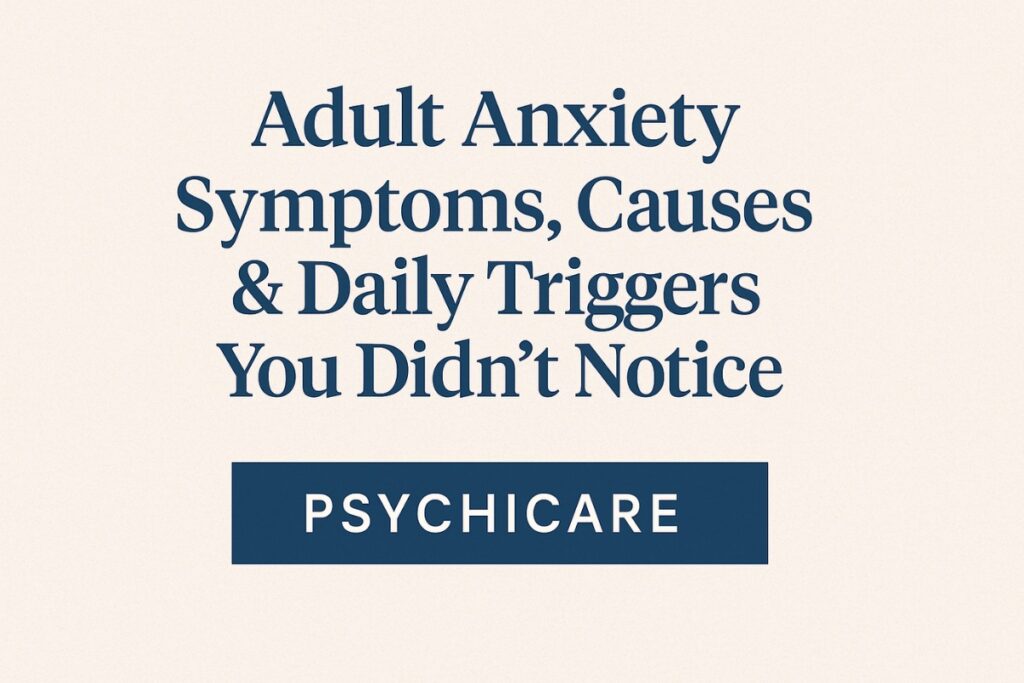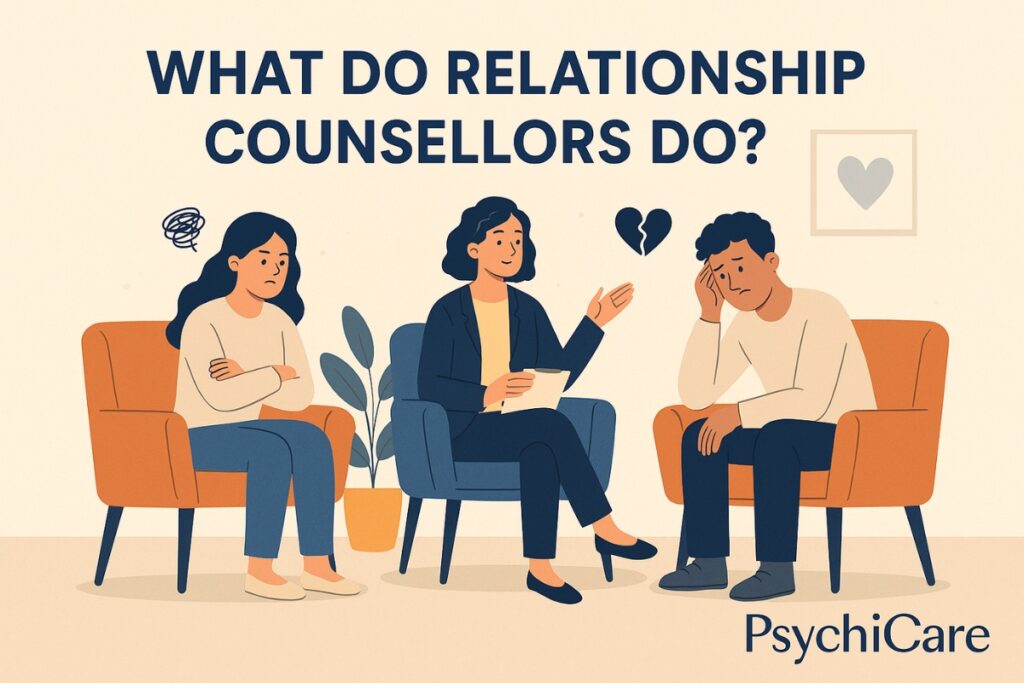Updated: November 2025 · Reviewed for accuracy and expanded with clearer therapeutic insights.
Change the way you think, and everything changes.
When you feel trapped in cycles of overthinking, emotional burnout, or recurring conflict, Cognitive Behavioural Therapy (CBT) helps you break free.
It’s one of the world’s most trusted, evidence-based therapies, used by psychologists to treat anxiety, depression, trauma, sleep issues, relationship struggles, and more.
At PsychiCare, our licensed therapists use CBT to help individuals, couples, and even children rebuild emotional balance and resilience, not by “talking endlessly,” but by learning how to think differently, act purposefully, and feel better from within.
💡 In this guide, you’ll discover:
- What CBT really is and how it works in real life
- Why experts recommend it for mental health, relationships, and daily stress
- A complete list of conditions CBT helps with from marriage conflicts to insomnia
- How PsychiCare therapists personalise CBT for you
- FAQs, success insights, and how to start your first session
What Is Cognitive Behavioural Therapy (CBT)?
Cognitive Behavioural Therapy, or CBT, is a structured, goal-focused form of talk therapy that helps you understand the connection between your thoughts, feelings, and behaviours. It teaches you how to recognise negative thought patterns and replace them with realistic, balanced thinking so your emotions and actions naturally improve.
Unlike traditional counselling that may explore your past at length, CBT focuses on what’s happening right now, the patterns that are keeping you stuck, and gives you practical tools to change them.
The Core Idea: “Thoughts Create Feelings, Feelings Drive Actions”
CBT works on a simple but powerful model:
When your thoughts change, your emotions and behaviours follow.
For example:
- Thought: “I’m not good enough.”
→ Feeling: Hopeless, anxious.
→ Behaviour: Avoiding work, withdrawing from people.
CBT helps you catch such thoughts early, challenge their accuracy, and replace them with balanced alternatives:
“I’ve made mistakes, but I’m capable of improving.”
This shift changes everything: your confidence, relationships, and even physical health.
How CBT Differs from Other Therapies
CBT is:
- Structured: Each session has a clear plan, agenda, and goals.
- Collaborative: You and your therapist work together as a team.
- Practical: You apply techniques between sessions (homework) and track your progress.
- Short-term: Most CBT programs last 8–20 sessions, though deeper work can continue as needed.
What CBT Helps You Build
With CBT, you learn:
- Awareness of automatic negative thoughts
- Emotional regulation skills
- Problem-solving and stress management
- Healthier communication in relationships
- Confidence to face challenges instead of avoiding them
CBT is not just about reducing symptoms; it’s about learning skills that make life more manageable, balanced, and fulfilling.
How Cognitive Behavioural Therapy (CBT) Works in Practice
CBT isn’t a “just talk” therapy.
It’s a structured, step-by-step process that helps you understand your mind, test your thoughts, and change the habits that keep you stuck.
At PsychiCare, we follow a clinically proven approach that’s both evidence-based and deeply personalised because every mind works differently.

Step 1: Understanding Your Thought Patterns
The journey begins with self-awareness.
Your therapist helps you spot automatic thoughts, the quick, often unnoticed messages you tell yourself every day. For example:
“They didn’t text me back. I must have said something wrong.”
“If I can’t sleep tonight, tomorrow will be a disaster.”
These patterns are written so deeply that they can feel like the truth. CBT teaches you to pause and examine them, rather than reacting immediately.
Step 2: Identifying the Links Between Thoughts, Feelings, and Behaviours
Once you start noticing your thought loops, your therapist helps you map them using the CBT triangle – Thought → Emotion → Behaviour.
Example:
- Thought: “I always mess things up.”
- Emotion: Sadness, guilt.
- Behaviour: Avoiding new tasks or socialising.
Seeing this connection is often an eye-opening moment; it shows that your emotions are not random, they’re shaped by what you tell yourself.
Step 3: Challenging and Reframing Negative Thinking
Here’s where change begins.
You learn to question the evidence behind your negative beliefs and build new, balanced thoughts.
For example:
“What proof do I have that I always fail?”
“What’s a more balanced way to see this situation?”
Over time, these small shifts reshape your inner dialogue, turning self-criticism into self-coaching.
Step 4: Behavioural Experiments – Turning Insight into Action
CBT isn’t just mental work; it’s about doing.
You and your therapist design small behavioural experiments to test your new ways of thinking.
If you fear rejection, you might start a friendly conversation.
If you avoid presentations, you might practise with one trusted colleague first.
Every success (and even every failure) becomes data, not judgment.
This builds real-world confidence and helps your brain “learn safety” through experience.
Step 5: Homework and Daily Practice
Homework in CBT isn’t a chore; it’s your bridge between sessions.
You’ll be encouraged to:
- Keep a thought record or mood diary
- Practise relaxation or breathing exercises
- Track triggers and responses
- Try new coping or communication strategies
This repetition rewires your mental habits, the same way muscle memory builds in the gym.
Step 6: Reviewing Progress and Preventing Relapse
Towards the later stages, you and your therapist review:
- What’s improved
- What still feels difficult
- Which new skills need more practice
You’ll also build a relapse-prevention plan, identifying early warning signs of stress or anxiety, and how to respond before old patterns return.
Step 7: Applying CBT Beyond Therapy
The goal of CBT is independence, not dependency.
When therapy ends, you’ll leave with:
- A practical toolkit for managing thoughts and emotions
- Awareness of personal triggers
- Confidence to face uncertainty without spiralling
That’s what makes CBT life-changing: the skills stay with you long after the sessions end.
What to Expect from a CBT Session at PsychiCare
- Duration: 45–60 minutes (online or in-person)
- Format: Review, set goals, work on a skill, summarise, assign homework
- Tone: Collaborative, focused, supportive, never judgemental
- Therapists: Trained experts in CBT, trauma-informed, and relationship-sensitive care
Benefits of Cognitive Behavioural Therapy (CBT)
CBT is one of the most studied and effective forms of psychotherapy in the world. It’s recommended by global health authorities, including the NHS (UK) and the American Psychological Association, as a first-line treatment for many emotional and behavioural challenges.
But beyond the research papers and statistics, CBT’s power lies in its practicality.
It doesn’t just help you feel better; it teaches you how to manage your mind, emotions, and daily reactions.
Scientifically Proven, Humanly Grounded
CBT is evidence-based, meaning it’s been tested in thousands of clinical trials for issues like:
- Depression and low motivation
- Anxiety and panic attacks
- OCD and intrusive thoughts
- Trauma and PTSD
- Sleep difficulties (CBT-I)
- Addiction and unhealthy habits
- Relationship conflict and marital stress
- Chronic pain, fatigue, and health anxiety
Research consistently shows that people who complete CBT experience lasting improvement, not just temporary relief.
In many studies, CBT’s effectiveness is comparable to antidepressant medication, but with longer-term resilience once therapy ends.
Real-Life Benefits You Can Expect
When CBT is practised consistently, people often notice:
- Emotional clarity – You start identifying what you feel and why, instead of feeling “all over the place.”
2. Better stress control – You respond calmly to triggers that once overwhelmed you.
3. Improved relationships – You communicate more clearly and stop reacting impulsively.
4. Confidence and self-esteem – You learn to see yourself with more compassion and balance.
5. Healthier sleep and energy – Especially through CBT-I, your body relearns healthy rest cycles.
6. Lasting coping tools – You don’t just rely on your therapist; you build lifelong skills.
Why Therapists Love CBT
Psychologists often choose CBT because it:
- Provides structure and measurable progress
- Works for both short-term relief and long-term prevention
- Can be easily adapted for children, couples, and even groups
- Fits perfectly in online therapy settings (high engagement, visual tools, homework sharing)
At PsychiCare, our CBT specialists tailor every plan, whether it’s about overcoming intrusive thoughts, improving sleep, or resolving emotional disconnection in your marriage.
A Therapy That Empowers You
CBT isn’t about “fixing” you.
It’s about giving you a roadmap to understand your patterns, challenge them, and create emotional freedom on your own terms.
As one of our clients said:
“It felt like I finally had a manual for my mind, something school never taught me.”
What CBT Is Used For
Cognitive Behavioural Therapy isn’t limited to one kind of mental health issue; it’s a flexible framework that can be adapted to almost every emotional, behavioural, and relational challenge.
At PsychiCare, we use CBT across a wide range of areas from individual mental health to marriage counselling, sleep therapy, and even chronic stress management.

1. Depression and Low Mood
CBT helps you break the vicious cycle of negative thoughts, low energy, and withdrawal.
You’ll learn to:
- Identify “all-or-nothing” or self-critical thinking
- Rebuild daily structure and motivation through behavioural activation
- Reconnect with pleasure, purpose, and small achievements
CBT teaches that depression isn’t weakness; it’s a pattern that can be retrained.
2. Anxiety, Panic, and Worry
For anxiety and panic disorders, CBT is often the first-line therapy recommended by psychologists worldwide.
You’ll discover how to:
- Recognise triggers that fuel worry loops
- Challenge catastrophic predictions
- Use exposure techniques to reduce avoidance
- Learn calming strategies like grounding and thought defusion
Whether it’s health anxiety, panic attacks, or social fears, CBT helps you regain control of your mind.
3. Obsessive–Compulsive Disorder (OCD)
In OCD, unwanted thoughts trigger compulsive rituals or reassurance-seeking.
Through Exposure and Response Prevention (ERP), CBT helps you gradually face feared thoughts or situations without performing the compulsion. Over time, your brain learns that anxiety fades naturally, and you regain freedom from repetitive behaviours.
4. Trauma, PTSD, and Emotional Flashbacks
CBT, especially Trauma-Focused CBT (TF-CBT), helps you process past experiences that continue to shape your emotions today.
It includes:
- Gently confronting distressing memories in a safe way
- Rewriting beliefs like “I’m to blame” or “I’m never safe”
- Learning grounding tools to calm your body and mind
This approach is effective for both childhood trauma and adult post-traumatic stress.
5. Relationship and Marriage Counselling
CBT isn’t only for individuals; it’s a game changer in couples therapy.
When partners feel misunderstood or stuck in conflict, CBT helps uncover hidden thought patterns like:
- “They never listen to me.”
- “If they loved me, they’d know what I need.”
CBT-based couples therapy helps partners:
- Communicate assertively instead of defensively
- Replace blame with empathy
- Build emotional safety and connection again
6. Sleep Problems and Insomnia
CBT for Insomnia (CBT-I) is one of the most effective, non-medication treatments for poor sleep. It helps you:
- Identify habits that keep your brain alert at night
- Correct anxious thoughts about sleep (“If I don’t sleep, I’ll fail tomorrow”)
- Rebuild healthy bedtime routines and sleep associations
Many clients report better rest within a few weeks without needing sleeping pills.
7. Eating Disorders and Body Image
CBT helps people struggling with emotional eating, bingeing, or strict food control by targeting the underlying thought patterns.
It works to:
- Challenge rigid beliefs about food and body shape
- Reduce guilt and perfectionism
- Build mindful eating habits
When combined with nutritional guidance, CBT supports long-term recovery and body acceptance.
8. Addiction and Compulsive Behaviours
Whether it’s alcohol, nicotine, gaming, or social media overuse, CBT helps uncover the emotional triggers that drive addictive patterns.
It focuses on:
- Identifying high-risk thoughts (“I need this to calm down”)
- Building coping skills and relapse prevention plans
- Finding alternative sources of reward and stress relief
CBT helps you regain a sense of control, not deprivation.
9. Anger, Irritability, and Impulse Control
If anger feels unmanageable, CBT helps you understand what’s underneath it: frustration, shame, unmet needs, or distorted thinking.
It teaches:
- Early awareness of physical signs (tension, heart rate)
- Cognitive techniques to pause before reacting
- Assertive communication to express needs without aggression
CBT doesn’t suppress anger; it helps you channel it constructively.
10. Chronic Pain and Health Anxiety
CBT has strong results for people managing long-term physical illnesses or pain.
By changing your mental response to pain, you can reduce distress and improve functioning.
It focuses on:
- Reducing catastrophising (“It will never get better”)
- Building pacing and activity plans
- Managing anxiety about health symptoms
11. Co-Parenting and Family Dynamics
Family relationships often trigger recurring emotional cycles, anger, guilt, withdrawal, and control. CBT helps parents and family members:
- Identify reactive communication styles
- Replace blame with understanding
- Practise calm, consistent boundaries
It’s especially effective for co-parenting counselling and families managing stress after separation.
12. Stress, Burnout, and Work-Life Imbalance
CBT gives professionals tools to manage overthinking, performance anxiety, and perfectionism. You’ll learn:
- How to reframe unhelpful beliefs (“If I’m not perfect, I’ll fail”)
- Set realistic expectations
- Create mental “off-switches” to prevent burnout
It’s one of the most empowering forms of self-management therapy for modern life.
13. Self-Esteem and Personal Growth
Low self-esteem isn’t a personality flaw; it’s often built on distorted thinking.
CBT helps you:
- Replace harsh self-talk with evidence-based self-worth
- Stop over-apologising or people-pleasing
- Build inner confidence that’s not dependent on external validation
14. Life Transitions and Adjustment Issues
Big changes – moving cities, divorce, loss, job shifts – can shake emotional stability. CBT provides tools to cope, adapt, and regain balance. It helps you make sense of uncertainty and find emotional footing again.
15. Online CBT: Flexible, Accessible, Effective
Through PsychiCare’s online CBT sessions, you can access therapy wherever you are. Online CBT maintains the same structure – goal setting, skill-building, feedback but adds convenience and privacy. It’s especially beneficial for clients balancing busy schedules or living abroad.
Cognitive Behavioural Therapy (CBT) at PsychiCare helps people manage depression, anxiety, trauma, sleep problems, relationship conflicts, and stress through evidence-based psychological tools and real-world skill-building.
Specialised Forms of CBT at PsychiCare
While traditional CBT is highly effective, modern psychology has evolved several specialised versions of it. At PsychiCare, our therapists tailor each form of CBT to fit your emotional needs, personality, and life context because therapy works best when it fits you, not the other way around.
1. Mindfulness-Based Cognitive Therapy (MBCT)
MBCT blends classic CBT techniques with mindfulness practices, helping you stay aware of your thoughts without being consumed by them.
This approach is especially effective for:
- Recurrent depression and rumination
- Chronic stress and burnout
- Emotional reactivity and overthinking
MBCT teaches you to observe your mind rather than fight it, allowing peace, clarity, and acceptance to grow naturally.
At PsychiCare, our MBCT sessions include guided mindfulness, breathing exercises, and cognitive reframing for deeper emotional calm.
2. Trauma-Focused CBT (TF-CBT)
Trauma-Focused CBT helps individuals process painful or distressing experiences that continue to affect their emotions, relationships, or sense of safety. It’s widely used for both children and adults facing post-traumatic stress, abuse, or sudden loss.
TF-CBT focuses on:
- Gently revisiting trauma memories in a controlled, safe way
- Challenging beliefs like “It was my fault” or “I can never trust again”
- Rebuilding emotional safety and self-worth
This method has strong evidence for reducing PTSD symptoms and restoring stability.
. Cognitive Behavioural Couple Therapy (CBCT)
Relationships thrive on communication, empathy, and trust, and CBT can strengthen all three.
In CBCT, both partners learn to:
- Identify unhelpful thinking patterns (“They always…” “You never…”).
- Replace assumptions with real communication.
- Manage anger, defensiveness, and resentment constructively.
- Rebuild shared meaning and emotional intimacy.
Couples often discover that most conflicts aren’t about “the issue,” they’re about how each partner interprets it. CBT helps couples rewrite these interpretations to create a connection again.
4. CBT for Insomnia (CBT-I)
CBT-I is a science-backed, medication-free treatment for chronic sleep problems.
It helps you identify and reverse the habits and thoughts that interfere with restful sleep.
At PsychiCare, we teach you to:
- Reset your body’s sleep rhythm
- Challenge anxious thoughts like “I’ll never fall asleep”
- Build healthy sleep hygiene and bedtime routines
In most studies, CBT-I works better than sleeping pills and its benefits last longer.
5. CBT for Children and Adolescents
Children often express distress through behaviour, not words. Our therapists adapt CBT for younger minds using stories, drawings, and interactive games to teach coping and self-regulation.
CBT for children helps with:
- School anxiety, peer pressure, exam stress
- ADHD and impulse control
- Family conflict and low confidence
Parents are part of the process too, learning how to reinforce CBT tools at home.
6. Online CBT (e-CBT)
In today’s world, convenience and privacy matter. Online CBT brings therapy to your home – same structure, same results, just virtual.
At PsychiCare, our online CBT sessions are:
- Secure and confidential
- Conducted via video or chat
- Supported by digital worksheets and progress tracking
Online CBT is ideal for clients living abroad, managing tight schedules, or simply preferring a familiar environment for deep conversations.
7. Schema-Focused CBT (Advanced CBT for Deep Patterns)
Some people struggle not with one issue but with lifelong emotional patterns like fear of abandonment, perfectionism, or self-sabotage. Schema Therapy, an advanced form of CBT, dives deeper into these long-standing beliefs formed in childhood.
It combines cognitive techniques with imagery, role play, and emotional repair to reshape how you relate to yourself and others. This is especially useful for chronic anxiety, relationship trauma, and low self-worth.
What Happens During a CBT Session at PsychiCare
Starting therapy can feel intimidating especially if you’ve never done it before. That’s why we keep our CBT sessions structured, safe, and focused, so you always know what’s happening and why.
Every session at PsychiCare is a space for reflection, discovery, and growth, not judgement or labels.

Session Duration and Format
- Length: 45–60 minutes per session
- Mode: Online (video or chat) or in-person (where available)
- Frequency: Weekly or biweekly, depending on your goals
Most CBT programmes run for 8–20 sessions, though some clients choose ongoing sessions for maintenance or deeper work.
Step 1: Assessment and Goal-Setting
Your first session is about understanding you.
Your therapist will listen to your story – what’s been troubling you, what patterns you’ve noticed, and what you hope to change.
Together, you’ll define clear goals such as:
- “I want to sleep better.”
- “I want to stop overthinking small mistakes.”
- “I want to communicate calmly with my partner.”
The therapist then creates a personalised plan – outlining the tools, techniques, and timeline of your CBT journey.
Step 2: Learning the CBT Model
In the early sessions, you’ll learn how your thoughts, emotions, physical sensations, and actions are interconnected. This “CBT map” becomes your toolkit for self-awareness.
You’ll also start tracking your thoughts using simple worksheets or apps – a powerful step toward noticing what’s happening inside you rather than being swept up by it.
Step 3: Identifying and Challenging Negative Thoughts
Once awareness builds, you’ll begin to identify the beliefs that fuel your stress, anxiety, or conflict.
Your therapist will gently guide you to question those beliefs:
- “What evidence do I have for this thought?”
- “Is there another explanation?”
- “What would I tell a friend who felt this way?”
Bit by bit, you’ll replace harsh inner dialogue with realistic, balanced thinking.
Step 4: Behavioural Experiments and Practice
This is where you start testing new perspectives in real life.
If you fear rejection, you might try initiating a conversation.
If you avoid sleep due to racing thoughts, you’ll practise a CBT-I bedtime routine.
If communication feels impossible, you’ll try a structured couples exercise.
You’ll record what happened, how you felt, and what you learned, then discuss it next session. Each experiment builds real-world confidence and rewires old patterns.
Step 5: Emotion Regulation and Coping Tools
CBT includes grounding, relaxation, and problem-solving techniques to handle intense emotions. You might learn:
- Deep breathing or guided imagery for anxiety
- Assertive communication for anger or guilt
- Reframing techniques for guilt, shame, or failure
These tools make therapy practical – something you can apply at work, home, or in relationships.
Step 6: Tracking Progress and Adjusting Goals
Progress is regularly reviewed with your therapist. You’ll discuss:
- What has changed in your thinking or mood
- What new skills feel natural
- What areas still need work
This data-driven approach ensures therapy remains effective and motivating, you see how far you’ve come.
Step 7: Relapse Prevention and Maintenance
In the final stages, you’ll design a relapse-prevention plan. It includes:
- Early warning signs to watch for
- Coping strategies to use if stress returns
- How to keep practising CBT independently
Some clients choose a monthly “check-in session” to stay accountable and grounded.
What a PsychiCare CBT Session Feels Like
Most clients describe their sessions as:
- “Structured but gentle.”
- “A conversation where I learn about myself.”
- “Practical – I always leave with something useful.”
Our therapists balance science with empathy – using evidence-based CBT tools but delivering them in a warm, human way that fits your pace.
How Long Does CBT Take?
Every person progresses differently, but Cognitive Behavioural Therapy (CBT) is designed to bring noticeable results fast. Most clients at PsychiCare start feeling better within 4–6 sessions, while full treatment usually runs 8–20 sessions.
Typical CBT Journey
Phase 1: Understanding (Sessions 1–2)
→ Assessment, goal-setting, and mapping your thought patterns.
Phase 2: Skill Building (Sessions 3–6)
→ Learning CBT tools, challenging unhelpful thoughts, early relief from anxiety or low mood.
Phase 3: Real-World Practice (Sessions 7–10)
→ Behavioural experiments, communication exercises, sleep or stress management strategies.
Phase 4: Maintenance (Sessions 11–20)
→ Strengthening new habits, relapse prevention, long-term confidence.
What Affects Duration
- Complexity of your concern
- Regular practice between sessions
- Trust and connection with your therapist
- Support from family or environment
When You’ll Notice Change
By week 4–5, many clients report:
- Calmer reactions to stress
- More balanced thinking
- Improved sleep or focus
- Stronger self-control in relationships
Small mental shifts often lead to big life changes.
Why Choose PsychiCare for CBT
At PsychiCare, CBT is never a one-size-fits-all method. Our therapists blend proven science with genuine empathy, helping you rebuild emotional balance through structured, practical, and compassionate care.
Expert, Licensed Therapists
Work with experienced psychologists trained in CBT, trauma recovery, marriage counselling, and child therapy. We focus on lasting change by teaching skills you can use every day.
Global, Multilingual Support
You can access our CBT sessions securely from anywhere in the world. Our therapists speak English, Hindi, Tamil, and Bengali, ensuring comfort and understanding at every step.
Tailored, Measurable Care
Each treatment plan is customised to your goals, whether you’re managing anxiety, depression, relationship stress, or sleep issues. We measure progress together so you can see your growth.
Safe, Supportive Environment
Our sessions are confidential, non-judgemental, and paced around your comfort. Therapy should never feel intimidating, only healing.
Integrative Healing
When needed, we combine CBT with other approaches such as mindfulness, schema therapy, or couples counselling for deeper, longer-lasting results.
PsychiCare’s CBT program helps you think clearer, feel stronger, and live with renewed confidence, one step, one thought at a time.
Frequently Asked Questions about Cognitive Behavioural Therapy (CBT)
CBT: What is Cognitive Behavioural Therapy?
Cognitive Behavioural Therapy is a structured form of talk therapy that helps you identify and change unhelpful thought and behaviour patterns. It focuses on building practical skills to manage anxiety, depression, stress, and emotional challenges effectively.
CBT: How long does therapy take?
CBT usually lasts between 8 and 20 sessions. Many people notice improvements within four to six sessions, depending on the issue, consistency of practice, and engagement during therapy.
CBT: Can it help with relationships or marriage issues?
Yes. CBT helps couples recognise unhelpful thinking, communicate more clearly, and manage emotional triggers that cause conflict. It is often used in modern relationship and marriage counselling to rebuild understanding and trust.
CBT: Does CBT work for sleep problems?
Yes. CBT for Insomnia (CBT-I) helps identify habits and beliefs that disturb sleep. It teaches healthier sleep routines and ways to calm racing thoughts without medication.
CBT: Can children or teenagers benefit from it?
Yes. CBT can be adapted for younger minds through creative, activity-based techniques that teach emotional regulation, confidence, and coping skills suitable for their age.
CBT: Is it effective for trauma or PTSD?
Trauma-focused CBT helps individuals process painful memories safely, reduce flashbacks, and challenge beliefs like guilt or helplessness. It is widely recognised as an effective treatment for post-traumatic stress.
CBT: How is it different from regular counselling?
Unlike open-ended counselling, CBT is goal-oriented and structured. It focuses on changing the way you think and act, using evidence-based tools and measurable progress.
CBT: Can I do CBT online?
Yes. Online CBT provides the same structure and results as in-person sessions. It’s convenient, private, and accessible from any location, ideal for clients with busy or international lifestyles.
CBT: Will CBT change my personality?
No. CBT doesn’t change who you are; it helps you manage thoughts and emotions more effectively, so you can respond to life with balance and confidence.
CBT: What kind of results should I expect?
Most clients experience reduced anxiety, improved sleep, better mood, and clearer thinking. Over time, you’ll develop tools to maintain emotional stability long after therapy ends.




